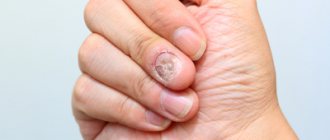Why are scratches dangerous?
Every child gets new scratches almost every day. For some they are a “serious injury”, but for others they are signs of combat valor. Adults try to be more careful and cautious. But even they sometimes fail to avoid scratches. And not everyone likes this, because crimson stripes do not in the least decorate the image of a respectable person. How to remove scratches on your hand quickly? This question worries everyone who accidentally gets scratched. But do not forget that any scratch is not only a cosmetic defect. Any damage to the integrity of the skin is an open gate for infections. It is for this reason that every cut or scratch needs timely antiseptic treatment. Even those that seem insignificant at first glance.
First aid for superficial skin injuries
How to properly treat scratches on your hands and face? Start by washing the wound with an antiseptic solution. Any product from your first aid kit will do: alcohol, hydrogen peroxide, Miramistin. Please note that antiseptic solutions that do not contain alcohol have a gentle effect on the skin and at the same time effectively disinfect the wound. Alcohol and alcohol lotions can dry out and burn sensitive skin. If you are “lucky enough” to get scratched while working in the garden, it makes sense to start by washing the affected limb in plain water with antibacterial or laundry soap. After this, use an antiseptic. Then lubricate the scratch with iodine or brilliant green. For deep or large skin lesions, it is recommended to apply a bandage. If the scratch is small, but is in an “inconvenient” place, it makes sense to cover it with a band-aid.
Warnings
- If you have a severe cut or burn, do not use the methods described in this article and seek immediate medical attention.
- Protect the cut from exposure to sunlight, as scarring may occur (especially if the cut is exposed to the sun for more than 10 minutes).
Cuts are a violation of the integrity of the mucous membranes or skin by any object with sharp edges. Very often a glass cut occurs, with the wound having cut edges and bleeding and pain.
Surely you have had such situations when you were walking barefoot along the beach and suddenly felt a sharp pain in the foot area. This is a glass cut on the leg, treatment of which should be started as soon as possible, because the wound can quickly become contaminated, which is fraught with complications.
We will tell you how to provide first aid for glass cuts and heal such a wound quickly and without undesirable consequences.
How long does it take for scratches and cuts on the skin to heal?
The healing time of superficial damage to the skin depends on many factors. One of the most important among them is the body’s individual ability to regenerate tissue. It is believed that abrasions and scratches on the hands heal most quickly in childhood. Superficial skin damage goes away quite quickly and without consequences in people with good immunity and leading a healthy lifestyle. Do not forget that the healing time also depends on the depth of the scratch and its type. Shallow wounds heal in a matter of days without special care. How long does it take for a scratch on a hand to heal on average? If you disinfect the wound in a timely manner, after about 3-7 days not a trace will remain of it. It is believed that scratches left by domestic and wild animals last the longest. There are many folk and pharmacological remedies that can speed up the process of tissue regeneration. How to help a scratch heal faster?
Stages of healing
Wounds, scratches, cuts happen every day. To make it easier to understand first aid in such cases, you should know the four stages of treatment:
1. Inflammation
The body's immediate defense response to any injury is to dilate the blood vessels to speed up the transport of blood to the injured tissue - the blood vessels become more permeable, allowing fluids and white blood cells (leukocytes) to be transferred from the blood to the tissues. Increased blood flow causes unpleasant but transient symptoms:
- - increase in tissue temperature due to increased blood circulation;
- - redness due to vasodilation (dilation of blood vessels);
- - swelling caused by exudation of blood to the tissues;
- - pain due to increased tension and excess fluid in the tissues.
2. Thrombus
After a wound, for at least 10 minutes, depending on the extent of the injury, the body forms a clot (thrombus) that connects the edges of the wound to prevent excessive blood loss.
3. Removal of dead tissue.
White blood cells begin the process of absorbing microorganisms, dead cells and foreign substances, after cleaning the wound area. The damaged cells then release chemicals to stimulate blood flow and attract more white blood cells to the site of damage. Dead white blood cells containing excess microorganisms and decomposition products are partially removed through the lymphatic system and partially form purulent discharge.
4. Wound healing.
In the following days, general tissue and epithelium grow to replace the damaged skin surface. In case of extensive injuries, a scar forms over the entire surface of the wound. The immune system and white blood cells play another important role - they produce antibodies that help the body fight infection. Therefore, the healing process proceeds smoothly if the patient's general health is good. A weakened immune system significantly reduces the body's ability to fight infections and impairs wound healing. Fever, which occurs with extensive injuries from infection, is part of a protective mechanism - it helps fight infection (increased body temperature does not encourage the growth of harmful microorganisms) and speeds up the healing process (fever increases the flow of blood and nutrients to the area of injury).
Folk recipes
It's okay to get scratched while walking in nature. What to do if you forgot to take your first aid kit with you? Find a juicy plantain leaf, wash it and apply it to the wound. The indoor aloe plant also has antiseptic properties. Cut its leaf lengthwise and apply it to the wound. Scratches on the hands heal faster if a person has good immunity. Prepare an infusion of birch buds to maintain health and speed up healing. For half a glass of boiling water, take a tablespoon of raw materials. Instead of buds, you can use young birch leaves. Pour boiling water over the selected raw material and leave in a thermos for 2 hours. The finished infusion should be taken orally, 2 tablespoons three times a day. The course of taking this remedy is 5-7 days.
Pharmacological drugs
Your home medicine cabinet must contain antiseptic solutions for external use. When traveling and long walks, it is much more convenient to take sterile alcohol wipes with you. After initial treatment of the wound, the use of healing ointments and creams is allowed. The most popular among them are: “Rescuer”, Actovegin ointment and “Methyluracil”. You can also speed up healing by applying any product that contains panthenol to the injury site. To prevent scarring, the scratch can be treated with castor oil. How to properly use creams and ointments for superficial skin damage? If the scratch is on your hand or face, apply your chosen product liberally at night. Apply a bandage with an insulating layer on top that prevents the composition from being absorbed into the bandage or plaster.
Cream "Rescuer": instructions for use for scratches and abrasions
“Rescuer” is a healing balm made from natural ingredients. You can buy this cream today in all major pharmacy chains in our country. The product can be used for abrasions, scratches, cuts, hematomas, as well as irritation and dry skin. What’s especially nice is that the drug has virtually no contraindications, with the exception of individual intolerance. How to use Rescuer cream for scratches? Instructions for use suggest applying a moderate amount of balm to the affected area and lightly rubbing into the skin. When the product is absorbed, you can apply it again. “Rescuer” is also suitable for application to the skin followed by a bandage.
If the wound does not heal - reasons
It is true that chronic wounds are difficult to heal, especially in older people. However, problems with the wound are often associated with non-compliance with the rules of behavior - the wrong choice of hygiene, medication or neglect of them. Very often, therapeutic measures are aimed only at the wound, and not at removing the cause. And this is a mistake! Wound healing depends primarily on the underlying disease.
The most common mistakes that prevent wounds from healing are changing dressings too often.
The rule is this: the dressing should be changed as often as necessary and as little as possible. In the case of chronic wounds, it is changed once a week, and in case of heavy discharge from the wound - every 2-3 days. Frequent changes damage new, soft tissue and destroy reparative processes.
The second mistake is pouring disinfectant liquids into the wound (for example, hydrogen peroxide or salicylic alcohol, as well as iodine).
Wounds are also not treated with antibiotics. These disinfectants and antibiotics cause damage to healthy cells and slow wound healing.
The safest wound environment is normal saline and medications that prevent the entry of pathogens and infections from outside without damaging the wound environment. Vaseline or zinc-based ointment also cannot be classified as a good solution. They are used only to protect the skin around the wound.
- 1. Wounds are washed with saline, 0.9% or Ringer's solution. You should not use disinfectants - alcohol, iodine or hydrogen peroxide, because they destroy the newly formed, very delicate skin and granulation tissues that are newly formed.
- 2. Avoid frequent and excessive application of ointments, creams and gels to the wound (without consulting a doctor).
- 3. The wound should be kept in a moist environment, thanks to modern dressings. They do not stick to the wound surface and therefore do not cause tissue damage or pain.
- 4. The skin around the wound is nourished with preparations with a slightly acidic pH, which inhibits the growth of harmful bacteria.
- 5. The wound should not have any contact with clothing and the dressing should be placed so as to prevent contamination.
- 6. Depending on the stage of healing, the doctor indicates the frequency of changing the dressings, preferably once a week.
How to avoid scars from deep scratches?
Deep or very long scratches may take a long time to heal. Often, after their complete healing, scars and scars remain on the skin. How to prevent such a phenomenon and make the scratches heal without a trace? The first rule of caring for superficial skin damage: never peel off the crust that forms on the wound. If the scratch is in a moving place or constantly rubs against clothing, be sure to cover it with a band-aid. Never cover up superficial skin damage with decorative cosmetics. Most likely, it will still not be possible to hide them well. So why bother the wound once again? During the healing stage, you can use chemical peels and masks. Please note: abrasive scrubs should not be used on damaged skin. But products based on fruit acids will help to gently renew the skin.
Are scratches a reason to see a doctor?
If there is a scratch on your hand, what should you do? Few people take superficial skin damage seriously. In what cases do such injuries require specific treatment? It makes sense to see a doctor if the scratch is very large or deep. Sometimes, with such injuries, even suturing may be indicated. Do not delay a visit to the hospital even if the victim’s general condition has worsened after receiving an injury. If small scratches on your hands fester, become swollen and painful, this is also a reason to visit a doctor. It is likely that an infection has entered the body and you should immediately start taking antibiotics. Be careful about your health, because even the smallest scratch can cause big problems if not properly cared for!
Asks: Evgenia, Dalnegorsk
Gender: Male
Age: 15
Chronic diseases: No
Hello, I ask for help in the situation with my son. Son, 15 years old. Since the fall, I noticed cuts on my arms, from my hands to my wrists. Burns on the tissues, I assume from cigarettes. Some cuts heal, others do. All hands are covered in blue scars. When I ask why, he says it makes me feel better. I'm not in the mood and I'm cutting myself, it's so beautiful. He has a negative attitude towards death groups and condemns teenagers for this. About our family: I am divorced from my husband, he does not help my son financially, is not interested in him, those. They don't support the relationship at all. I live and never see him alone. There is an older brother, he lives in another city. I work shifts, spend a lot of time at work, my son is left to his own devices. He's a 3-level student, doesn't play sports, and doesn't talk interestingly. Listens to music, writes programs. I've been having problems with my classmates at school since this year. One of the boys, a former friend who beat him severely, wrote a statement to the inspectorate. After the incident with his son, the guys who communicated with him stopped. The son says, “I feel unpleasant and offended.” What to do, how to support my son in this situation?
What is selfharm or why do people cut themselves?
Everyone deals with feelings differently. Some may open up and talk to loved ones about their feelings. Others need a distraction - reading, watching a movie, or just taking a walk. These are healthy ways to cope with negativity. But for some, the only way to cope with emotions is to hurt themselves.
Self-harm is the deliberate act of self-harm and pain caused by the need to cope with strong emotions (such as anger, anxiety, or sadness). At the same time, self-harm rarely helps you feel better - all because of the guilt and shame that appears immediately after causing damage.
Signs and symptoms of selfharm
Typically, self-harm makes a person very secretive: he hides marks and scars so that they are difficult to detect. Most often, self-harm is an impulsive act, but sometimes methodical planning leads to it. It is most common in people who are coping with depression, anxiety, or eating disorders.
The most common signs that a person may be a victim of self-harm are: - Cut scars or burns that the person cannot explain
- Hair pulling
— Traces from pinches on the skin
— Bruises and abrasions
— Fractures
- Bite marks
— Attribution of constant bruises and cuts to clumsiness
- Clothing that is not appropriate for the season, such as trousers and long-sleeved shirts during the summer
- Low self-esteem
- Difficulty expressing and dealing with emotions
Reasons for self-harm
There are various reasons why people self-harm, but most often it acts as a strategy to cope with strong emotions.
This provides temporary relief and reduces anxiety, but this relief does not last long. Some people feel “numb” and try to regain some kind of sensitivity in this way.
Self-harm often acts as a punishment for imagined shortcomings or out of a feeling of self-hatred.
Certain factors increase the risk of self-harm.
For example, self-harm from close family members, childhood abuse (especially sexual abuse), stressful or traumatic life events, alcohol or drug abuse, impulsivity, poor coping skills and being self-critical.
Self-harm is also directly linked to depression, anxiety, post-traumatic stress disorder, eating disorders and borderline personality disorder.
Although self-harm is not usually associated with suicide, victims of self-harm are more likely to commit suicide due to its association with other emotional problems. Self-harm and related disorders are treatable, so if you or someone you love is experiencing it, it's important to look for a solution as soon as possible.
How to deal with the urge to harm yourself
We often hear about self-harm in the form of cutting in films and TV series, but this is not the only type of self-harm. It can manifest itself in the form of intentional burns or self-inflicted blows. This may seem like the only activity that will help you feel better.
Luckily, there are much healthier ways to cope. If you or someone you know has experienced self-harm, you should refer to this list to find a more effective way to deal with emotional problems. — Consultation with a psychotherapist.
The best way to learn how to cope with emotions is to get help from a professional. Therapy helps you combat self-destructive behavior, process and express emotions, and feel better. Many times people who suffer from self-harm are dealing with depression or an anxiety disorder.
If you seek help, be honest with your therapist, attend all appointments, and stick to your treatment plan.
- Investigate the causes of self-harm. By learning why you hurt yourself and what purpose you serve with these actions, you can combat this behavior. Think about why you started hurting yourself.
What makes you want to hurt yourself? How do you feel right before you cause damage? Is it always the same emotion? What do you do before you hurt yourself? This is important information for communicating with a therapist or mental health professional.
Journaling can help you answer these questions and serve as a positive way to cope with your emotions.
- Choose “healthy” actions. Often, if people manage to delay self-harm, the desire to harm themselves goes away. Choose healthy activities that you enjoy and make you feel better. This could be physical exercise, communication with loved ones, walking or a favorite hobby. When you feel the urge to harm yourself, immediately turn to one of the healthy alternatives.
— Collect a “calm down box.” Include a list of activities that will help you cope with your emotions, a favorite movie, a few good books, art materials, and your journal. Whenever you feel the urge to self-harm, open the box and choose a healthy option.
- Avoid anything that “inspires” you to self-harm. This may mean avoiding certain websites or stopping associating with people who “glorify” the idea of self-harm.
The post What is self-harm or why do people cut themselves appeared first on Smart.
Source: https://news.rambler.ru/other/37743707-chto-takoe-selfharm-ili-pochemu-lyudi-sebya-rezhut/
Site search
If you did not find the information you need among the answers to this question, or your problem is slightly different from the one presented, try asking an additional question to the doctor on the same page, if it is on the topic of the main question. You can also ask a new question, and after a while our doctors will answer it. It's free. You can also search for the information you need in similar questions on this page or through the site search page. We will be very grateful if you recommend us to your friends on social networks.
Medical portal website
provides medical consultations via correspondence with doctors on the website. Here you get answers from real practitioners in your field. Currently, on the site you can get advice in 43 areas: allergist, venereologist, gastroenterologist, hematologist, geneticist, gynecologist, homeopath, dermatologist, pediatric gynecologist, pediatric surgeon, pediatric endocrinologist, nutritionist, immunologist, infectious disease specialist, cardiologist, cosmetologist, speech therapist, Laura , mammologist, medical lawyer, narcologist, neurologist, neurosurgeon, nephrologist, oncologist, oncourologist, orthopedist-traumatologist, ophthalmologist, pediatrician, plastic surgeon, proctologist, psychiatrist, psychologist, pulmonologist, sexologist-andrologist, dentist, urologist, pharmacist, herbalist, phlebologist , surgeon, endocrinologist.
We answer 98.07% of questions
.
Stay with us and be healthy!
A scratch is a damage to the surface layer of the skin, which is limited in area and has a linear shape. The most common cause of scratches is careless handling of sharp and cutting objects at work or at home. In addition, the appearance of scratches may be associated with manifestations of aggressive behavior or careless communication with pets.
Types of scratches
Minor scratches on hands
Minor scratches can occur in the kitchen. This happens especially often in women when preparing food or doing household chores. But even a minor microtrauma can cause trouble if it is not treated with due understanding and treated in time.
To prevent infection from getting into the wound, the first thing you need to do is wash it with cold water and soap. If you have hydrogen peroxide, soak a cotton swab and apply it to the damaged area for ten to fifteen minutes. You can also use other disinfectants - iodine, brilliant green, chlorhexidine or potassium permanganate. If a child has a scratch, it is better to treat it with aqueous solutions of antiseptics, since alcohol solutions can cause pain and burning. After treatment, minor scratches do not need to be bandaged. Regularly lubricate dry scratches with ointments that accelerate healing and stimulate tissue regeneration.
Scratches on hands from a cat
Often, while playing with our beloved cat, we get scratches on our hands. Basically, such damage does not pose a danger, but in some cases there can be serious consequences.
The disease that occurs from scratching cats is called benign lymphoreticulosis. It is caused by the bacteria Bartonella henselae. Infection occurs when an animal's teeth and claws penetrate the skin. Half of the cats are carriers of this bacterium and appear completely healthy. It reaches the cat through the saliva of blood-sucking insects and fleas. In Russia, about a quarter of a million patients seek medical help every year with a similar problem. These are mainly children and young people. More often this happens in the cold season.
One day, Pharaoh Akhenaten became interested in a new passion. Then Nefertiti gave her a playful and aggressive kitten. The scratches caused the concubine to die of infection after a long illness. Nowadays people don’t die from this, but you need to know how to protect yourself from unpleasant consequences.
The incubation period of the disease is several days or several weeks. At the damaged area, the lymph nodes become inflamed and it swells. The temperature rises. After recovery, it happens that people with reduced immunity may be left with a secondary infection, damage to the nervous system, or meningitis. The person is not a carrier of the infection. You should consult a doctor in the following cases:
- The wound does not heal for a long time.
- Increased body temperature and enlarged lymph nodes.
- Other signs of a painful condition.
There are no specific medications for treatment. The doctor prescribes immunomodulators and antibacterial drugs. It is necessary to carry out long-term flea treatment and bathe the cat using disinfectant detergents. If your cat releases its claws while playing, try to wean it off by stopping contact. If she scratches you, immediately treat the damaged area with an antiseptic.
Deep scratch on hand
Deep scratches on the hand can occur as a result of falling on broken glass or wood chips. If the scratch was caused by an animal or dirt is brought into the wound, then you need to consult a doctor for the necessary treatment and consultation.
Understanding the classification
So, wounds are divided into the following types:
- Chipped. Such a wound can be obtained using an awl or a thin knife. A characteristic feature of such damage is not only the small diameter of the wound, but also the significant depth of the damage;
- Narrow. You can get such a wound from a glass cut. Attention! In this case, you need to very carefully examine the entire damaged surface for small glass fragments. Since they can bring you quite a lot of unpleasant moments in the future;
- Wounds with torn edges. You can become the owner of such damage when struck with a blunt object. Roughly speaking, in this case the skin simply bursts under pressure. The disadvantage of wounds of this type is the rather long healing process, since it is quite difficult to heal torn edges. And in most cases, you will still have to see a doctor for help, since the edges of the wound will need to be stitched.
Problems with a deep finger cut
In fact, what you might think is an ordinary deep cut of a finger can cause not only discomfort, but also cause quite large problems in the functioning of the injured limb.
For example, if some time after a cut you begin to feel that your finger is starting to go numb, then you should urgently seek medical help. This type of numbness may indicate damage to the nerve responsible for sensation. And it needs to be stitched urgently if you don’t want to lose sensitivity forever.
Another sign of impending problems is excessive bleeding, as this may be caused by a damaged artery. Another sign of damage to the artery that supplies your finger is blood leaking in spurts.
In this case, you should immediately bandage the finger above the cut with a tight bandage and raise your hand up. This way, the amount of blood flowing into your limb will decrease slightly and the bleeding will eventually stop.
If the edges of the wound constantly diverge, then the help of a doctor is also necessary. After all, such a cut will take a very long time to heal. And the likelihood of a wide, unsightly scar eventually appearing is almost 100%. And considering that beautiful hands are the calling card of every woman, you and I have absolutely no need for such consequences.
And, of course, another rather unpleasant and even dangerous consequence of such damage is infection in an open wound. Determining its presence is very simple: if after a while, contrary to healthy logic, the finger begins to hurt more and more, and the skin around the site of injury begins to redden and burn, then there is an infection!
In this case, you should not use all possible folk remedies and try to remove pus and inflammation on your own. Urgently go to consult a doctor, he will clean the wound from the already formed pus and prescribe you a healing ointment based on an antibiotic.
Cutting your finger: myths
It would seem, what myths can be associated with damage to finger tissue. And they exist! Well, for example, what is the first thing you do if you cut your finger? Try to lick the wound or put the injured limb under cold running water. This is exactly what is not recommended.
After all, no matter how deep the cut is, there are not enough blood vessels in our fingers for you to experience a lot of blood loss. But by sticking your finger under the water in the hope of quickly and effectively stopping the bleeding, you are actually creating all the favorable conditions for infection to enter the wound, since our water supply contains a huge amount of various microbes that are not very beneficial to health.
The same applies to licking the injury site. Only dogs have sterile saliva, but humans have microbes in their mouths quite well. Therefore, if you cut yourself, then raise your hand above your head and go towards the first aid kit for cotton wool and peroxide.
Also, do not lubricate an open wound with antiseptic ointments. In this case, you block the access of oxygen to the damaged epidermis, and this significantly delays the healing process.
And one more thing: if you are a fan of thickly lubricating the cut site with iodine, then know that this leads to the fact that all the epidermal cells that are in the immediate vicinity of the wound die, since you create a local burn.
Consequently, the healing time is increased. Iodine can only be applied to the skin around the injury site, so you can minimize the possibility of germs getting into the wound.
What to do if you have a deep cut on your finger
First of all, it is worth remembering that there is no reason to panic. Therefore, we calmly raise the hand with the injured finger upward, and with the healthy one we reach for our home first aid kit. First of all, you and I need to stop the bleeding. The ideal remedy for this is hydrogen peroxide. With its help we wash the wound.
Attention! If you see that your cut is too deep, then it is better to use peroxide to a minimum, since too many air bubbles can cause blockage of small blood vessels.
After the blood has stopped flowing heavily, it is advisable to treat the skin around the wound with iodine. Don’t be too zealous, because too dry wound edges don’t bode well either. After first aid has been provided, be sure to apply a tight bandage. There are also some nuances here. For example, you should not apply gauze directly to the wound.
Because in this case, even a non-expert knows that after the bleeding stops and you have to change the bandage, you will tear it off along with part of the epidermis, which will simply dry to it. To avoid such consequences, you must first wrap your finger in a small piece of plain paper. But this must be done so that the paper is completely wrapped around the phalanx.
After this, you can stick on a bactericidal patch or tie gauze. By the way, the paper holds the edges of the wound more tightly, which means the healing process occurs much faster.
Also, for faster healing, you can use special atraumatic dressings, which can be purchased at almost any pharmacy. Such dressings have special coatings, thanks to which the wound is constantly under the influence of antibacterial agents. For extreme cases, you can find bandages coated with a mild antibiotic.
After you have treated a deep cut on your finger, carefully monitor your condition for several days. And if the first signs of inflammation appear, consult a doctor immediately.
How to treat a cut finger: traditional methods
If you are sure that no nerve or artery is affected by the cut, then you can use traditional methods to speed up healing. For example, aloe leaves, which have an amazing antibacterial effect. The most effective way to use them is lotions.
They can be done a day after the cut, provided that the wound has already dried out a little. The procedure itself is as follows: take a small piece of cotton wool or gauze and apply fresh aloe juice to the entire surface. Apply the lotion to the wound for ten minutes. After this, we apply a regular bandage and go about our business.
The skin is the largest organ of the human body. When the skin is cut, complex biochemical processes begin to occur in the body aimed at tissue restoration. Treating cuts using natural herbal antiseptics and ointments can speed up the healing process and reduce the chance of scarring. In this article, we will tell you how to clean and treat cuts.
Scratches appear on the hands themselves
Sometimes small scratches spontaneously appear on the hands. One of the reasons may be hypothermia, when the hands become chapped. In such cases, rich cream or sea buckthorn oil helps.
The second cause may be allergic urticaria. It occurs in every fifth person. One type of disease is demographic urticaria, when irritation appears from physical or emotional stress, as well as from contact with substances that cause allergies. Irritation in the form of scratches on the hands occurs when rubbing against clothing or a blunt object. Allergies worsen with severe emotional stress. As a treatment, doctors recommend taking an antiallergic drug at night. The most common allergens include:
- medications;
- food products (fruits, nuts, eggs, fish);
- pollen of grasses and trees;
- viral infection;
- nutritional supplements
To make an accurate diagnosis, you need to conduct an examination. Take a general blood and urine test, feces for the presence of helminths, liver and serological tests. It is also necessary to do fluorography or chest x-ray. Treatment is carried out with corticosteroid drugs.
Preparations for rapid wound healing
There are hundreds of different types of drugs. They can be divided into the following types:
- • hydrogels (for example Intrasitegel, aquagel) - capable of absorbing exudate, maintaining high humidity, and also having cleansing properties, which leads to hydration of necrotic tissues;
- • hydrocolloids (for example Granuflex, Tegasorb), which are in the form of layered plates and upon contact with exudate form a gel, which occurs during the granulation process;
- • dextromers (for example Acudex, Debrisan) - dressing materials consisting of polysaccharide grains form a gel upon contact with wound exudate; used to treat large, deep and infected bedsores;
- • alginates dressings (for example, Kaltrostat, Tegagel.) - Dressings, natural polysaccharides obtained from seaweed with very high absorbent properties;
- • semi-permeable polyurethane film (for example, Opsite, Tegaderm.) - Capable of providing free evaporation of wound exudate from the surface, but not permeable to water and bacteria from the outside.
How to cure scratches
Due to soft tissue tears, scratches can take a long time to heal. If an infection occurs, the regeneration process is even slower. It takes at least three days to get rid of scratches.
First, rinse the damaged area well and then treat. You can make an iodine grid. If the scratch does not heal for a long time, use a special glue. This is not a cure, but will reliably protect against infection. Lubricate your skin with regenerating ointment.
How to remove scratches on hands
In people with good immunity, scratches heal quickly. If you use a wound healing agent or colloidal silver, the process will speed up.
Among herbal preparations, St. John's wort oil, aloe and plantain juice help well. If the damaged area is not inflamed, treat it with a decoction of oak bark. It has astringent and anti-inflammatory properties.
No matter how much you would like to cover the scratch with foundation until a crust appears, you should not do this. You can cause additional damage and infect the wound.
Diagnosis of cuts and incised wounds
Diagnostic procedures for cuts
usually not required except:
- deep cuts when there is suspicion of damage to large vessels, arteries and internal organs;
- complex combined wounds;
- cases where there is suspicion of:
- infection or inflammation of the wound,
- self-harm,
- violent injuries,
- the presence of foreign objects in the wound.
If an infection is suspected in a cut, a bacteriological culture can be taken from the wound to determine the pathogen and its sensitivity to antibiotics. However, in most cases this is not done, but local application or intramuscular administration of broad-spectrum antibiotics is immediately prescribed.
If damage to internal organs, large vessels is suspected, or in the case of complex combined wounds, depending on the specific circumstances, the following may be prescribed: ultrasound, CT or X-ray examinations.










